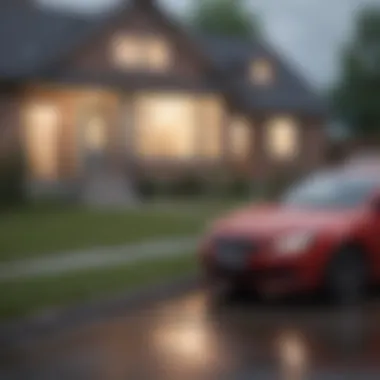Understanding Estimated Hazard Insurance for Property Owners


Intro
In the world of property investment and management, understanding the nuances of various types of insurance can significantly impact financial stability and asset protection. One crucial aspect that often surfaces is estimated hazard insurance. This form of insurance plays a pivotal role in safeguarding property from unexpected risks, essentially acting as a buffer against potential financial pitfalls.
As you venture into the realm of estimated hazard insurance, it’s imperative to grasp not only its fundamental concepts but also the methodologies involved in its estimation and implementation. In doing so, you'll be better positioned to make informed decisions, whether you’re a novice investor dipping your toes in or a seasoned property owner evaluating your coverage options.
This article aims to peel back the layers on estimated hazard insurance, shedding light on its significance, key components, and how it intertwines with broader aspects of financial planning.
To kick things off, we will explore the relevant investment terminology that shapes the discussions around hazard insurance, providing clarity on commonly used terms and industry jargon.
As we journey through this guide, you'll discover practical insights and strategies that can empower you to navigate the often murky waters of hazard insurance with confidence.
Prelude to Estimated Hazard Insurance
In a world where uncertainties loom large, especially concerning natural disasters, understanding estimated hazard insurance becomes paramount. The significance of this type of coverage cannot be overstated, as it serves as a vital safety net for homeowners and property investors alike. Rather than merely a precautionary measure, it plays a critical role in safeguarding investments and providing peace of mind.
Definition of Hazard Insurance
Hazard insurance is a specific type of insurance policy designed to protect property owners from financial losses relating to unexpected perils. This coverage usually includes risks like fire, theft, vandalism, and certain natural disasters. It is essential for anyone who owns or plans to invest in real estate to grasp exactly how this insurance functions. Knowing what is typically covered—and what isn't—helps individuals make informed decisions when selecting policies.
The term 'hazard insurance' can sometimes be used interchangeably with homeowners insurance; however, it uniquely focuses on protecting against specific physical risks rather than the broader aspects of homeownership—including liability or personal property.
Importance of Estimated Hazard Insurance
The role of estimated hazard insurance extends beyond simple financial protection. It is crucial for various reasons:
- Property Value Maintenance: In the unfortunate event of a disaster, having adequate hazard insurance can help retain property value. Investors know that a well-insured property is more attractive, reducing the risk of a significant financial hit.
- Peace of Mind: For many, the thought of losing everything to devastation is gnawing. This insurance alleviates that fear, ensuring property owners feel secure. Knowledge that they're covered means one can live without the lurking dread of financial ruin.
- Loan Requirements: Mortgage lenders often require proof of hazard insurance before approving loans. This condition not only enhances the lender's security but also ensures that homeowners maintain the necessary safeguards against potential losses.
- Risk Assessment and Management: Understanding estimated hazard insurance fosters a deeper comprehension of the risks present in specific locales. Various regions face different threats—be it floods, earthquakes, or hurricanes. Knowing these risks and the associated insurance can assist buyers in making smarter property choices.
"Effective hazard insurance contributes to a stronger community by mitigating the financial fallout from disasters, allowing for more rapid recovery and reinvestment."
By grasping the essentials outlined here, readers can appreciate the significant role estimated hazard insurance plays in not just individual finances but also broader economic stability. With the complexities of property investment in play, the importance of being well-informed on this matter remains unwavering.
Key Components of Hazard Insurance
Understanding the core components of hazard insurance is crucial. These elements lay the foundation for what an insurance policy covers and what it omits. Whether you’re a novice or someone with experience in insurance, grasping these details can greatly affect your disaster preparedness and financial security.
Types of Risks Covered
Hazard insurance isn't a catch-all solution; it specifically addresses certain types of risks. Generally, it covers the following:
- Fire Damage: This is common. If a fire breaks out, you want coverage to help repair or replace your property.
- Theft: Protection goes beyond your physical property. It includes losses from burglaries as well.
- Vandalism: In an age where property can be targeted unexpectedly, vandalism coverage comes into play.
- Natural Disasters: Be it a hurricane, tornado, or hailstorm, many policies offer coverage if a property is damaged due to these events.
It's important to note that NOT all risks are covered. For example, standard hazard insurance might not cover flooding or earthquakes. Add-ons or separate policies often handle those.
Many homeowners assume various hazards are covered under their regular policies. This is a misunderstanding that can lead to significant financial issues down the line. People should get a full view of what is included in their policies.
Coverage Limits and Exclusions
Delving into coverage limits and exclusions is like reading the fine print of a contract; you must understand what it truly means for your overall insurance strategy.
Coverage Limits determine the maximum amount an insurance company will pay out for a covered loss. Common limits include:
- Policy limit on structure: This is the replacement cost of the home itself. Knowing what your house is worth is vital here.
- Contents coverage limit: This refers to personal items inside your home. Items like electronics, furniture, and clothing may have a set maximum.
"Being underinsured can lead to financial ruin; knowing your limits helps prevent that."
Conversely, certain exclusions can trip up policyholders if they aren't paying attention. Common exclusions include:
- Floods: Standard policies usually exclude flood damage, pushing homeowners to seek flood insurance separately.
- Earthquake damage: Not every hazard insurance policy covers earthquakes, so it's essential to look elsewhere if you live in a vulnerable area.
- Routine wear and tear: Maintenance issues often fall on homeowners, meaning these wouldn’t be covered.
Ultimately, knowing what isn’t covered is just as crucial as understanding benefits. The aim is to dodge nasty surprises that could disrupt your financial foundation while safeguarding your future.
The Process of Estimating Hazard Insurance
Understanding the process of estimating hazard insurance is crucial for property owners. It can mean the difference between keeping your assets safe and exposing yourself to potential financial pitfalls. There’s a method to the madness, as they say, and knowing how estimates are derived gives individuals leverage when navigating the insurance landscape.


In the realm of hazard insurance, getting the estimation right not only protects property but also ensures that you are paying a fair premium that matches the risk involved. Underestimating can lead to disastrous circumstances in case of a calamity, while overestimating can pinch your wallet unnecessarily. Thus, finding that sweet spot is where accuracy in estimation comes into play.
Data Sources for Estimation
When it comes to estimating hazard insurance, the data sources used are pivotal. Insurance companies rely on a mix of historical information, geographical data, and real-time assessments to form their estimates. Data can be gathered from:
- Public Records: Ownership history, previous claims, and building permits provide a wealth of information.
- Meteorological Data: Reports on natural disasters and weather patterns help in assessing risk levels.
- Real Estate Market Trends: Understanding the fluctuations in property values in particular areas gives context to the risk of hazards.
Using a variety of sources ensures that the assessment is well-rounded, taking into account multiple facets of risk that may not be immediately visible.
Methods of Calculation
Calculating estimated hazard insurance comprises several methods, each with its unique advantages and drawbacks.
Comparative Analysis
Comparative analysis is a widely adopted approach in the estimation process. This method focuses on evaluating similar properties in equivalent geographical areas to derive an insurance estimate. The allure of comparative analysis lies in its ability to ground estimates in real-world data.
- Key Characteristics:
- Utilizes sales and claims data from comparable properties.
- Offers a more relatable context to property owners.
What makes this method particularly popular is its relatability. Property owners can look to their neighbors and similar properties to assess what coverage they might need. However, one unique feature of comparative analysis is that it can sometimes fail to account for individual property conditions and specific risks, which could lead to either underinsurance or overinsurance.
Statistical Modeling
On the flip side, we have statistical modeling, which digs deeper into numerical data to project hazard risk. This method uses advanced algorithms and analytical strategies to identify patterns and relationships in data, allowing for a more nuanced estimate of hazard insurance.
- Key Characteristics:
- Leverages large datasets and statistical techniques.
- Provides predictions that can adjust for numerous variables.
The pivotal advantage of statistical modeling is its ability to offer a more customized estimate based on various factors, from geographic features to historical claims. However, it does come with its drawbacks; it can sometimes be perceived as overly complex, leading to potential misunderstandings about risk that aren’t readily apparent to property owners.
Analyzing the Impact of Estimated Hazard Insurance
Understanding the repercussions of estimated hazard insurance is key for anyone navigating the complex landscape of property management or investment. It’s not just about protecting a building or property from potential risks; it extends to examining how such insurance affects the broader financial framework for property owners. This section digs deep into the vital essence of estimated hazard insurance, illuminating its multifaceted impacts that can reverberate through both property values and financial planning efforts.
Effects on Property Values
One of the most immediate consequences of estimated hazard insurance is how it influences property values. When considering or purchasing a property, potential buyers often weigh not just the physical aspects of the property, but also the surrounding risks and liabilities. If a property is covered by a robust hazard insurance policy, it signals to buyers that the owners are proactive about risk management. Conversely, properties lacking such coverage may be viewed with skepticism, potentially diminishing their market appeal.
This is particularly true for homes located in areas susceptible to natural disasters, like floods, hurricanes, or wildfires. A strong hazard insurance estimate can instill confidence in buyers, positively affecting the property’s valuation.
- Properties with adequate hazard insurance often fetch better resale prices.
- Buyers may offer less on properties with insufficient or unclear hazard coverage, fearing unforeseen liabilities.
Furthermore, areas with a reputation for comprehensive hazard insurance may experience higher demand, affecting overall property values positively. Maintaining a proactive stance with hazard insurance reflects a responsible approach to investment, appealing to both buyers and investors alike.
Financial Planning Implications
When it comes to financial planning, estimated hazard insurance serves as a cornerstone for effective budgeting and long-term security strategies. Investors and homeowners should recognize that hazard insurance costs are not merely expenses—they are an essential part of a larger framework designed to safeguard financial health.
In preparing budgets, it is essential to factor in potential hazard insurance expenses. Not only does this allow individuals to allocate resources thoughtfully, but it also mitigates the risk of being blindsided by unexpected repair costs after a disaster. Without appropriate coverage, one might find themselves in a precarious position, unable to recover fully from financial setbacks.
Some critical considerations include:
- Risk Assessment: Knowing the risks associated with a property can guide the necessary insurance adjustments, thus optimizing expenses.
- Emergency Funds: Regularly evaluating insurance estimates ensures adequate emergency funds, specifically set aside for potential disasters, are maintained.
- Tax Implications: In some cases, hazard insurance can play a role in tax deductions, which savvy investors can benefit from.
Differences Between Hazard Insurance and Other Insurance Types
Understanding the distinctions between hazard insurance and other types of property insurance is pivotal for those looking to make informed decisions. Each insurance type serves a unique purpose, covering different risks that property owners might face. This section lays bare the nuances that set hazard insurance apart, thereby guiding both novice and seasoned investors in their decision-making process.
Comparison with Homeowner's Insurance
When discussing insurance for property, many people typically think of homeowner's insurance. Homeowner's insurance is a robust package that usually combines various coverage components such as dwelling protection, personal property, liability, and additional living expenses. Its intent is to provide a broad spectrum of protections for homeowners.


On the other hand, hazard insurance primarily focuses on protecting the structure of the home from specific perils. These often include natural disasters like fire, windstorms, and hail. In essence, hazard insurance is a segment of the broader homeowner’s policy. Homeowner's policies tend to encompass hazard insurance as just one facet of the overall package.
Some key points of comparison include:
- Focus on Structure vs. Content: Hazard insurance concentrates mainly on the physical structure of a home, while homeowner’s insurance covers both structure and personal property.
- Liability Coverage: Homeowner's insurance often comprises liability coverage, which is absent in standard hazard insurance policies.
- Additional Living Expenses: If your home is rendered uninhabitable due to a covered peril, homeowner’s insurance can cover living expenses while repairs are made. This is generally not a feature of hazard insurance alone.
Distinctions from Flood and Earthquake Insurance
Flood and earthquake insurance represent specialized forms of coverage that protect against specific disasters. These two forms of insurance operate in stark contrast to hazard insurance, which is generally broader yet less detailed regarding certain risks.
Flood damage isn't typically included in standard hazard insurance; property owners usually must seek flood insurance separately. This separation often catches homeowners off guard, especially those living in areas prone to flooding. Similarly, earthquake insurance, usually not covered under hazard insurance, can be essential for those in earthquake-prone zones, requiring a unique policy for protection.
Considerations when comparing hazard insurance with flood and earthquake insurance include:
- Tailored Coverage: Flood and earthquake insurance policies are specifically designed for those natural disasters, offering a layered protection approach absent in standard hazard insurance.
- Regulatory Requirements: In high-risk regions, flood insurance may not be optional, often mandated by mortgages, whereas homeowners may not always realize the implications of relying solely on hazard insurance for more severe risks.
- Different Claims Processes: The claims processes can differ significantly between these insurances. Flood and earthquake claims are often subject to different regulations, which may involve stricter guidelines and varying timelines.
"Hazard insurance secures homeowners against specific risks, but without flood and earthquake coverage, you might be left high and dry after a disaster."
In summary, while hazard insurance protects the structural elements of property, homeowner’s insurance offers a more comprehensive safety net. On the flip side, flood and earthquake insurance fill crucial gaps left by hazard insurance, ensuring broad-scale, disaster-oriented protection. Understanding these differences is paramount to a sound financial plan that adequately protects property investments.
Practical Tips for Obtaining Hazard Insurance
Obtaining hazard insurance is not just a checkbox on a to-do list for property owners; it’s a crucial step in safeguarding your investment. Given the unpredictability of certain events, ensuring you have adequate hazard coverage can be the difference between financial security and substantial loss. This section offers insightful strategies to help you in finding the right coverage tailored to your unique needs.
Researching Insurance Providers
When it comes to finding an insurance provider, doing your homework is kind of like studying for a big exam. You need to gather all the right information to make a sound decision. Here are some steps you might want to consider:
- Start with Referrals: Speak to friends, family, or colleagues who have experience in obtaining hazard insurance. Word-of-mouth recommendations are often credible and can point you in the right direction.
- Utilize Online Resources: Websites like reddit.com or facebook.com can offer real-life experiences and insights about different insurance providers. Simpler advice may come from looking at forums where people discuss their own dealings with insurers.
- Check Ratings and Reviews: Entities like AM Best or the Better Business Bureau provide ratings on insurance providers. A company with high ratings generally indicates a reliable provider.
- Compare Quotes: Don’t just settle for the first quote you receive. Take your time to compare several providers. This might save you money and ensure you get the best coverage.
Finding a good insurer is a bit like fishing—throwing out different lines can help you catch the best deal.
Understanding Policy Terms
After narrowing down your options, the next step is diving deep into the policy documents. Reading the fine print can feel like translating a foreign language; that’s why understanding the terms and conditions is vital.
- Know the Jargon: Terms like “deductible,” “premium,” “exclusions,” and “riders” can be overwhelming but are critical in discerning the specifics of your policy. Familiarize yourself with these terms to avoid any nasty surprises down the line.
- Clarify Coverage Limits: Each policy will have set limits on how much it will pay out. Ensure you comprehend these limits and don’t hesitate to ask your provider if the coverage is adequate for your property’s value.
- Ask About Exclusions: Learn what is not covered. Certain disasters might be overlooked, and understanding these exclusions helps you gauge whether you need additional coverage.
- Review Policy Adjustments: Finally, don’t forget to ask how often policies are reviewed and updated. As your property value changes, so too should your coverage. Regular engagement with your insurer can prevent any gaps in protection.
Remember, clarity is key. You wouldn’t sign a contract without reading it, right? Make sure to voice your concerns and seek explanations on anything that feels murky.
Being informed is half the battle; understanding gives you the advantage.
Maintaining Adequate Hazard Insurance Coverage
Maintaining a robust hazard insurance coverage is akin to having a solid safety net; it cushions the blow when unexpected events occur. This section underscores the importance of keeping your hazard insurance up to date and aligned with your unique circumstances. Without regular attention to this aspect, one may find themselves underinsured in times of crisis, leading to financial distress or worse—an inability to recover fully from a disaster.
One of the principal benefits of maintaining adequate coverage is that it helps to safeguard your investment. Your property is not just a structure; it represents years of hard work, savings, and dreams. Hence, ensuring that you have a sufficient safety blanket against loss is crucial. Property values aren’t static; they shift over time based on a variety of factors, from market trends to environmental changes. Falling behind in adjusting coverage accordingly can lead to vulnerabilities that could have been easily avoided.
Regularly Reviewing Coverage Needs
Reviewing your coverage needs regularly isn’t merely a suggestion; it’s essential. Life is unpredictable, and just as your life circumstances change, so too can the hazards that threaten your property. It’s wise to sit down at least annually and reevaluate:
- Changes in Property Features: Any home improvements—like adding a deck or renovating a kitchen—could affect your insurance needs. If you upgrade, you should also think about upgrading your coverage.
- Local Risk Factors: Some areas may face new risks due to changing environmental conditions. For instance, if your locality sees an increase in wildfires or flooding, ensuring you have adequate coverage for these specific threats becomes vital.
- Personal Financial Situation: Financial growth or hardship can alter how much risk you're willing to take on. A house that was once a modest investment might now be your primary asset, demanding a reevaluation of how much coverage you need.
Adjusting for Changes in Property Value
Another critical aspect of maintaining adequate coverage is adjusting for fluctuations in property value. Over time, the market can rise and fall—one minute your home is worth a pretty penny, and the next, it’s nose-diving in value. It’s not just about keeping up with market trends; it's about understanding that property values can change dramatically due to various factors.
- Market Conditions: It’s imperative to stay updated on local real estate developments which can affect property values. A new shopping center or school can elevate nearby property prices; conversely, an economic downturn can have the opposite effect.
- Restorative Costs: Should disaster strike, will your existing coverage allow you to rebuild or repair to the same standard? As construction costs rise, even if property value doesn’t dramatically fluctuate, the cost of replacing what you’ve lost might. Regularly revisiting your coverage ensures that your policy keeps pace with these potential expenses.
Maintaining adequate hazard insurance coverage is critical for financial resilience in the face of life’s uncertainties. By actively managing your policy—through regular reviews and adjustments—you equip yourself to face unexpected events with greater peace of mind.
The Role of Hazard Insurance in Disaster Preparedness
Hazard insurance plays a vital role in preparing for disasters. Its importance cannot be understated, especially when we consider the growing frequency and intensity of natural disasters worldwide. Homeowners and property investors must understand how this type of coverage protects not just their assets, but their financial futures. The insight offered here serves as a roadmap for navigating this critical aspect of disaster preparedness.


Understanding Potential Natural Disasters
Natural disasters come in various forms, ranging from hurricanes and earthquakes to floods and wildfires. Each of these events carries its own set of risks and consequences. For instance, a homeowner living in an area prone to wildfires must consider the implications of property destruction and the subsequent recovery costs.
Here are several common types of natural disasters and their potential effects on property:
- Hurricanes: Powerful storms that can cause structural damage, flooding, and prolonged power outages.
- Earthquakes: Sudden ground movements that can compromise foundations and lead to devastating collapses.
- Floods: Often the result of heavy rainfall or melting snow, floods can devastate neighborhoods and lead to long-term mold issues.
- Wildfires: Destructive fires that can sweep through regions, leaving ashes where homes once stood.
The unpredictable nature of these disasters underscores the necessity of having adequate hazard insurance coverage. Each incident not only threatens people's homes but also their mental and emotional well-being. Moreover, understanding the specific risks related to one’s geographical location equips property owners with the knowledge to seek appropriate insurance solutions.
Integrating Insurance into a Comprehensive Risk Management Plan
An effective risk management plan goes hand-in-hand with hazard insurance. This strategy requires a holistic approach to managing exposure to risks. Here are essential components to include in such a plan:
- Risk Assessment: Evaluate the likelihood of various natural disasters affecting your property. This helps in determining the coverage needed.
- Insurance Coverage: Choose a hazard insurance policy that covers the specific risks of your region. Ensure that the coverage limits are adequate and that you’re aware of any exclusions.
- Emergency Preparedness: Formulate an action plan for responding to a natural disaster. This includes having supplies, evacuation routes, and emergency contacts ready.
- Financial Planning: Assess the financial implications of potential loss. This could involve budgeting for higher deductibles or setting aside funds for additional repairs post-disaster.
As a rule of thumb, integrating insurance into a comprehensive risk management plan offers peace of mind. It serves as a financial buffer, facilitating quicker recovery when disasters strike.
"Insurance is not just a product, it's a safety net that catches you when the unexpected happens."
Hazard insurance, when woven into the fabric of a robust risk management strategy, not only shields property but lays the groundwork for resilience in the face of calamity. For both novice and seasoned investors, recognizing this connection is paramount in building a secure financial future.
Regulatory Environment Surrounding Hazard Insurance
The realm of hazard insurance operates within a framework constructed from both state and federal regulations. This regulatory environment is crucial. It not only shapes the landscape of coverage available but also ensures that policyholders receive fair treatment and adequate protection against potential risks.
Navigating this regulatory maze can prove to be a daunting task, especially for those who are not well-versed in legal jargon. Yet, understanding these regulations is vital for any property owner or investor. After all, it's not merely about obtaining coverage but doing so in a way that aligns with legal standards while providing robust protection to assets.
The following sections will explore two major components of the regulatory framework: the intricacies of state regulations and the overarching federal guidelines that govern hazard insurance.
State Regulations and Requirements
Each state has its own unique set of regulations governing hazard insurance. These rules are not arbitrary; they often arise in response to the specific risks that regions face. For instance, states prone to wildfires, like California, have stringent requirements that address these risks comprehensively. On the flip side, areas that experience hurricanes, such as Florida, have a different set of rules geared towards those environmental challenges.
Here are some key points regarding state regulations:
- Licensing: Insurers must be licensed in the states they operate, ensuring they meet local financial stability requirements.
- Rate Approval: Many states require insurance companies to obtain approval before increasing rates. This protects consumers from sudden hikes in premiums.
- Mandatory Coverages: Certain states may mandate specific levels of coverage for hazard insurance. Understanding these requirements is crucial for meeting legal obligations.
- Consumer Protections: State laws often include guidelines for transparency in policy language. This aims to prevent jargon overload, enabling policyholders to understand what they’re getting into.
It's important for property owners to familiarize themselves with their local regulations to avoid potential gaps in coverage.
Federal Guidelines and Support Programs
While state regulations lay the groundwork, federal guidelines provide a broader context for hazard insurance. The federal government can influence risk management practices, especially in areas prone to significant natural disasters.
Several notable points about these guidelines include:
- National Flood Insurance Program (NFIP): This program, overseen by FEMA, provides federally backed flood insurance to property owners in participating communities. Understanding how this interacts with hazard insurance is vital.
- Fair Housing Act: This act aims to eliminate discrimination in housing practices, which indirectly affects hazard insurance by ensuring equal access to coverage.
- Disaster Assistance: In the wake of natural disasters, federal support programs may be available to aid those affected. This can provide supplementary benefits that complement hazard insurance policies.
"Policyholders should remain aware of the evolving federal guidelines as they can significantly affect overall coverage and support related to hazard insurance".
In essence, the regulatory landscape surrounding hazard insurance is intricate, with state and federal laws influencing how policies are crafted and executed. Staying informed is essential for any property owner or investor seeking reliable coverage.
Future Trends in Hazard Insurance Estimation
The landscape of hazard insurance is changing, much like the weather itself. As the world encounters evolving risks from climate change and technological advancements, it becomes essential to explore these future trends in hazard insurance estimation. This area is not merely about adjusting premiums or tweaking policies; it's about understanding how to tailor coverage to meet new realities. For investors and property owners alike, recognizing these trends can enhance risk management and potentially save significant sums in the long run.
Emerging Technologies and Their Impact
The advent of technology is transforming how we estimate hazard insurance. Innovations such as satellite imaging, big data analytics, and geographic information systems (GIS) provide insurers with more accurate data than ever before. These tools track hazard risks in real-time, creating a detailed picture that can inform both pricing methodologies and policy offerings.
- Satellite Imagery: Insurers can assess properties from above, spotting risks like flooding or fire hazards more efficiently.
- Big Data: Gathering vast amounts of data allows for sophisticated analyses. Insurers can ask questions like: How often does a particular area experience extreme weather? What is the historical loss in specific neighborhoods?
- GIS Technology: This helps in visualizing potential hazards and their impact on properties. By mapping these risks, insurers can create more tailored policies.
The integration of artificial intelligence can streamline claims processes and efficiency, getting payouts to those affected faster. Like a well-oiled machine, this tech synergy will redefine the insurance experience for consumers. Understanding these emerging technologies is pivotal for both insurers and policyholders, as it links directly to cost, coverage, and overall service.
Shifts in Consumer Demand and Preferences
As society becomes more environmentally conscious and technologically savvy, consumer preferences are shifting. Homeowners today are often looking for more than just basic coverage; they seek policies that reflect their values and address contemporary risks.
- Eco-Friendly Options: There’s a growing demand for insurance products that encourage sustainable practices. Green homes tend to use materials and designs that minimize hazard risk, prompting some insurers to offer discounts or special terms.
- Customizable Policies: Many consumers now want the ability to tailor their coverage. This demand for flexibility means insurers must adapt their offerings to allow for personal adjustments based on unique risk profiles and lifestyle factors.
- Focus on Education: As information becomes readily available, consumers are better equipped to understand their coverage needs. Insurers that prioritize customer education find favor among informed consumers.
"Understanding the future of hazard insurance estimation isn’t just about anticipating changes; it’s about preparing for them to ensure optimal protection."
Through these emerging technologies and evolving consumer preferences, the future of hazard insurance estimation is promising, with both challenges and immense potential for adaptation and growth.







